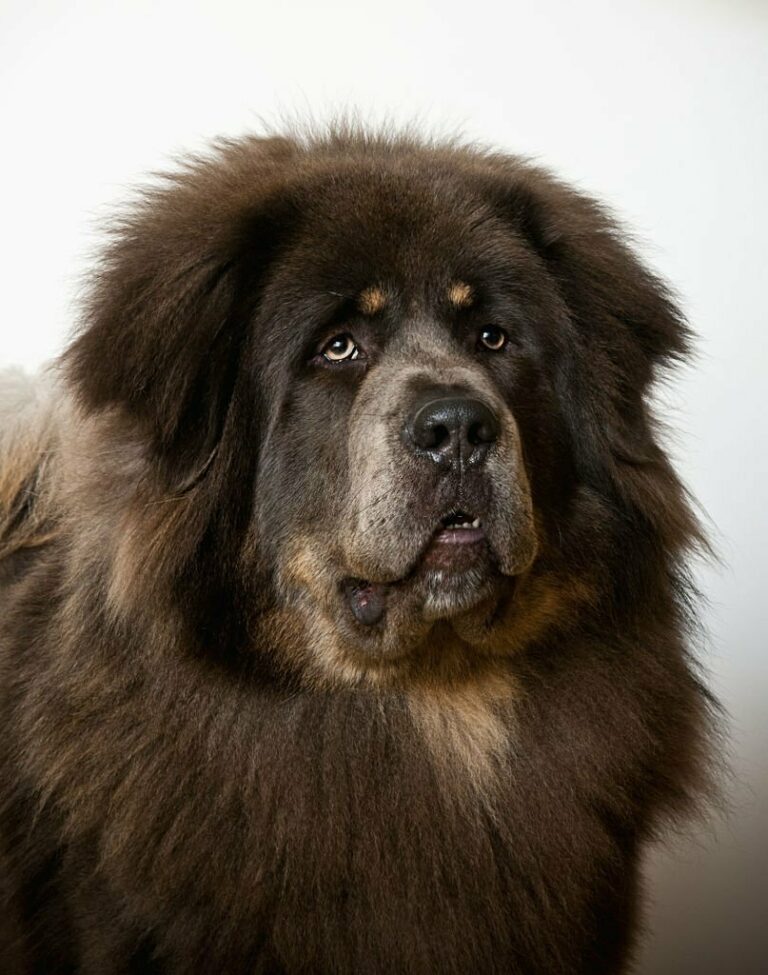Tibetan Mastiff Dog Breed
The Tibetan Mastiff is known for its majestic presence and loyalty, originating from Tibet’s challenging terrain. Often seen as a symbol of protection, this breed has a long history of guarding property and animals.
Their thick double coat keeps them warm in cold weather, and their size is imposing, with males usually standing at least 26 inches tall. Females are a bit smaller but still part of the large breed category.
These dogs balance a reserved nature with genuine warmth towards their families and are selective about whom they trust. They’re intelligent and independent, so they need dedicated training and social interaction from an early age.
Owners should understand their specific health, nutrition, and grooming needs to keep a Tibetan Mastiff healthy and happy.
Key Takeaways
- Tibetan Mastiffs are loyal guards from Tibet’s harsh landscapes.
- Their thick coats and large size command respect.
- Proper care demands understanding their health and grooming needs.
Quick Facts
The Tibetan Mastiff stands tall and proud, with males reaching at least 26 inches and females 24 inches. These dogs also carry significant weight, with males ranging from 90 to 150 pounds and females from 70 to 120 pounds. Their large build isn’t just for show; it reflects their history as powerful guard dogs.
These purebreds combine strength and a solid presence to deter threats effectively.
They also have a long lifespan for their size, living on average between 10 to 12 years. Known for their noble and alert nature, Tibetan Mastiffs have earned respect worldwide, making them valued members of the Working Group.
They are sought after for their loyalty and ability to serve as faithful protectors in various settings but sometimes, they are aloof.
Tibetan Mastiff Dog Breed Pictures
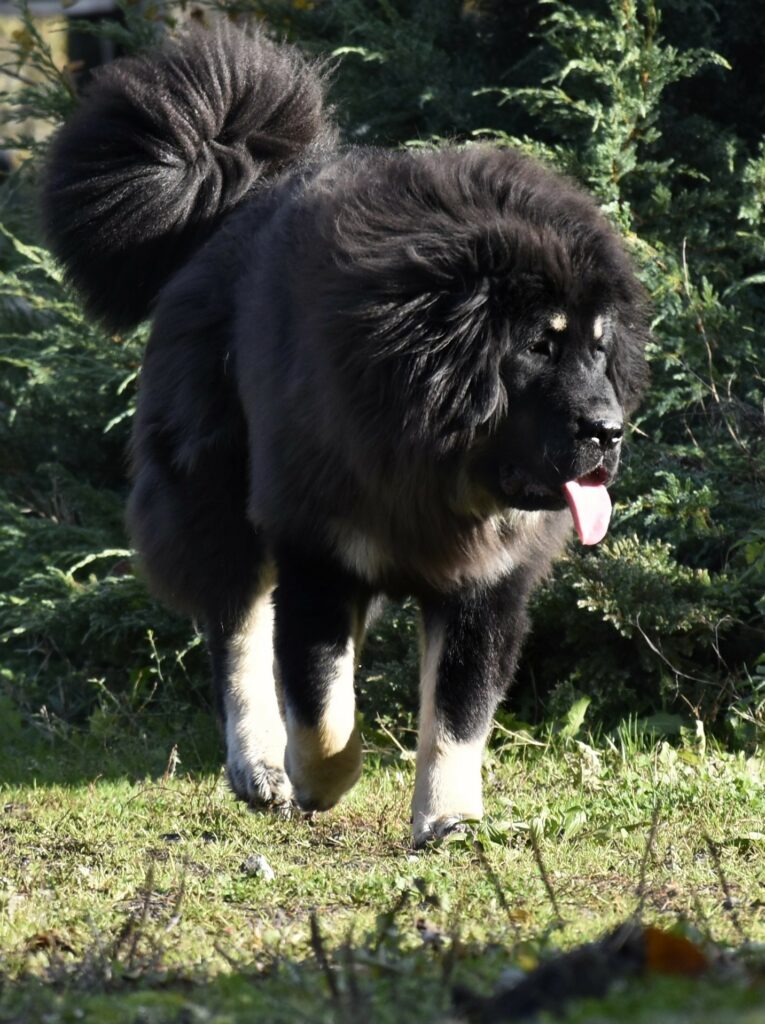
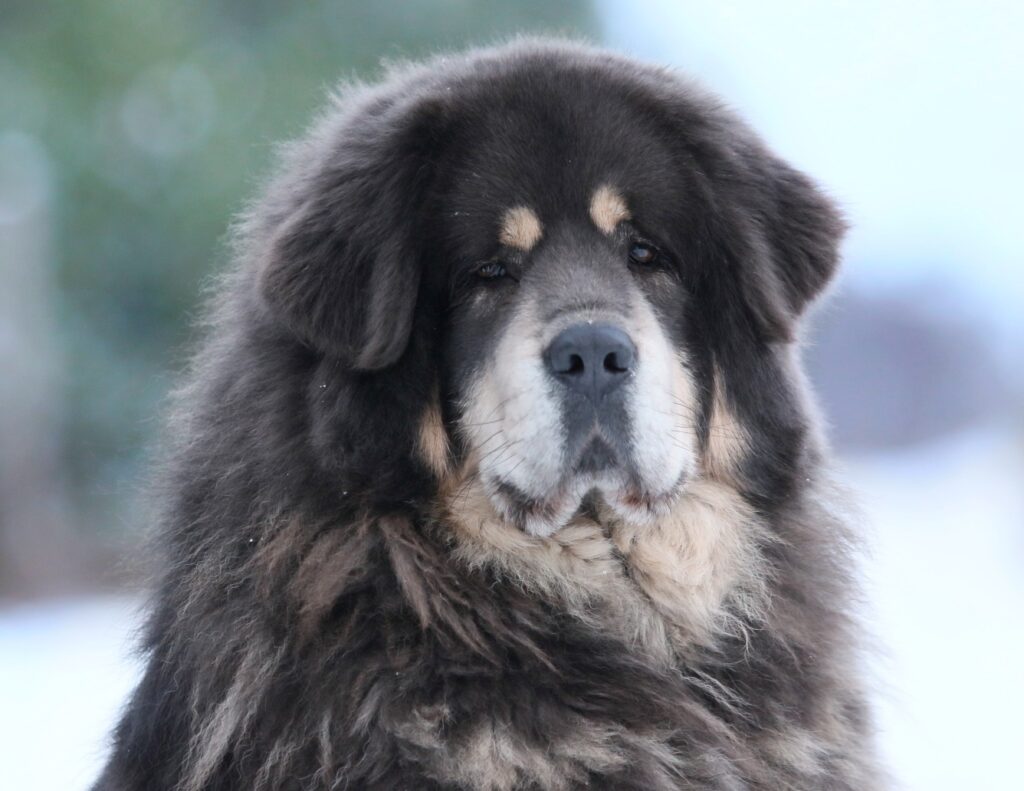
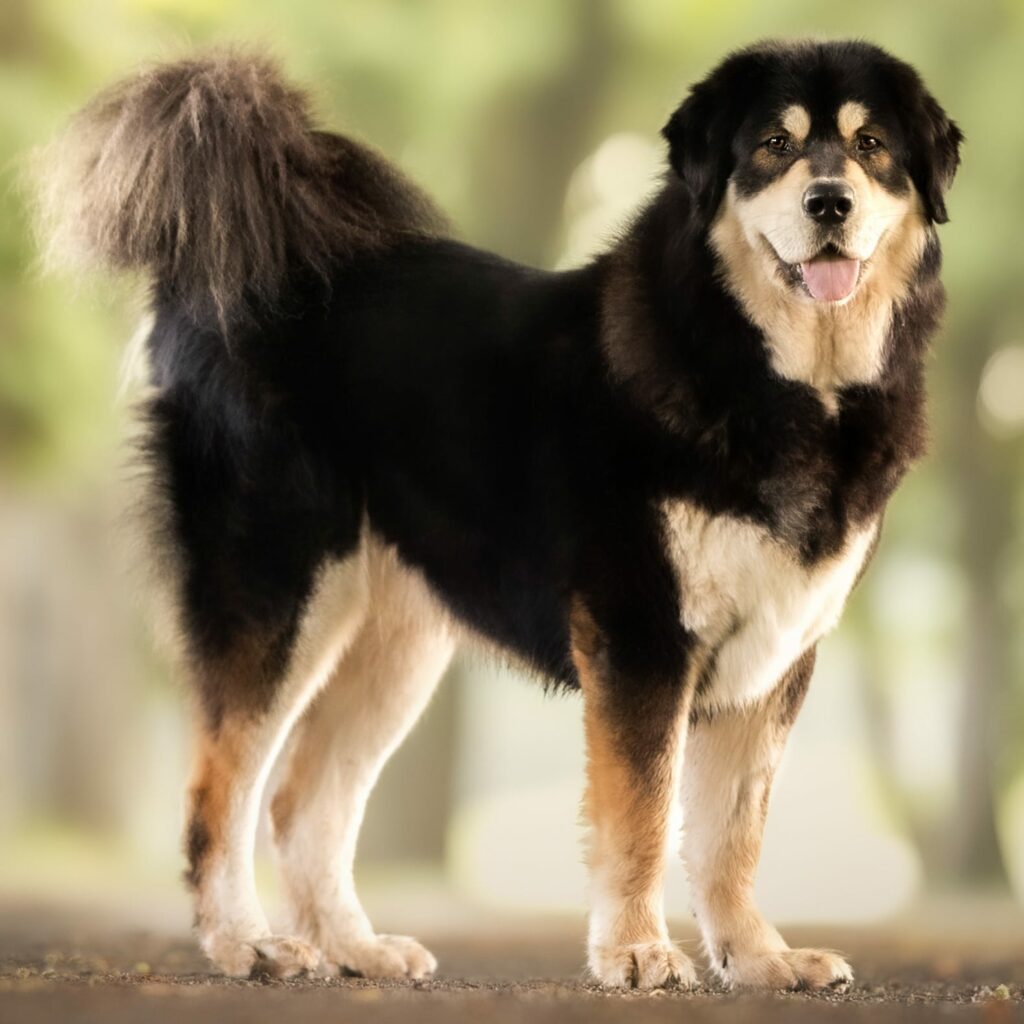
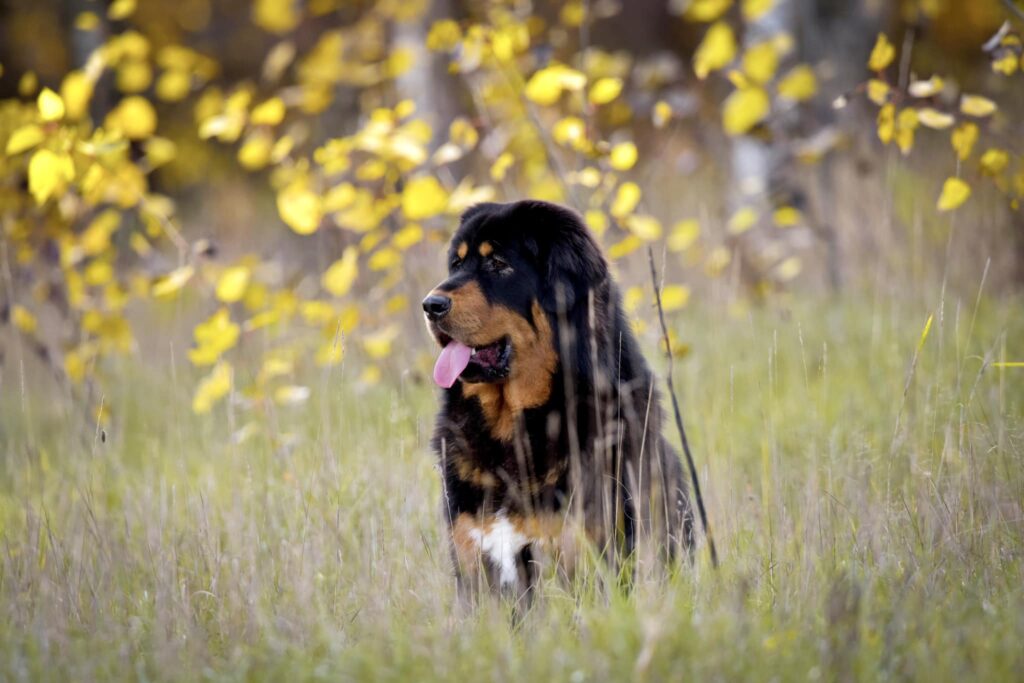
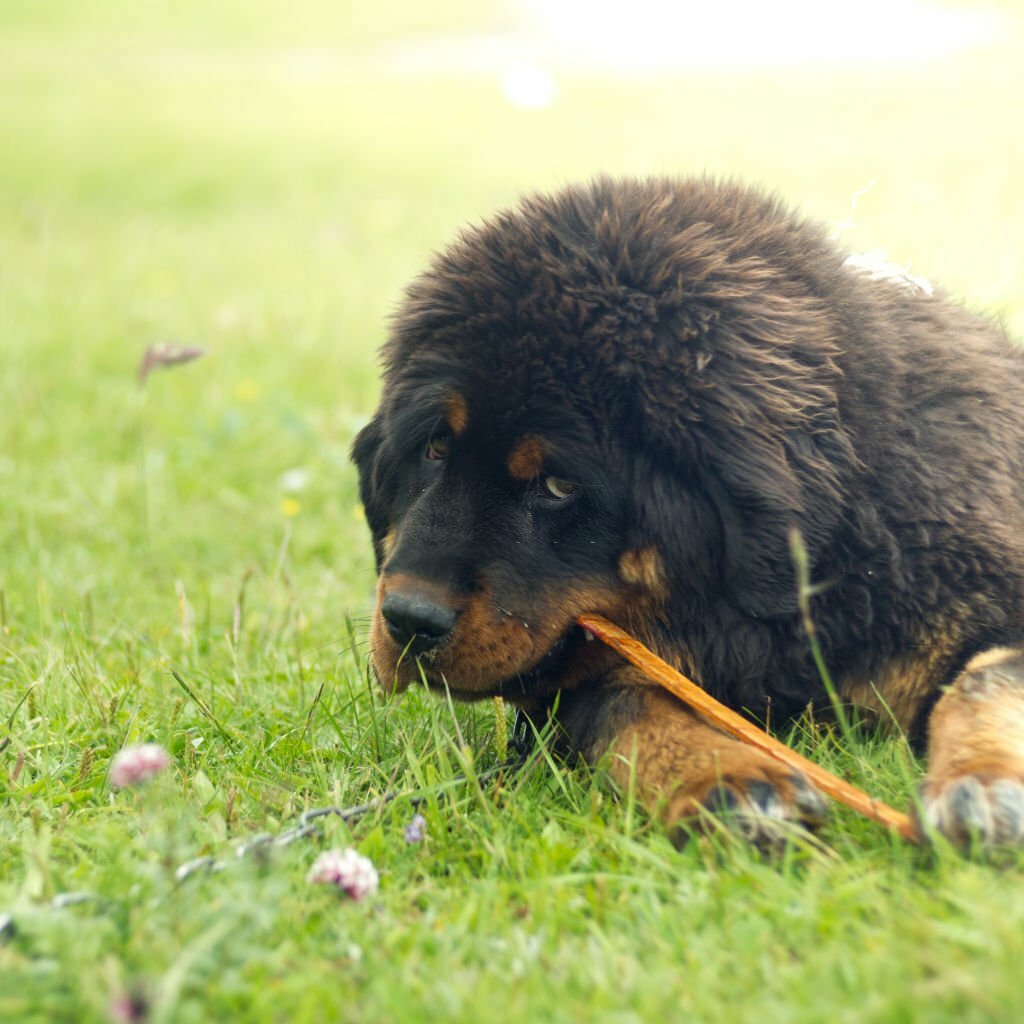
Overview
The Tibetan Mastiff is known for its protective nature and impressive stature. Originating from the challenging environments of Central Asia, this large breed has been a reliable guard for nomadic herders and monasteries throughout history.
With a muscular build and a thick coat that shields it from the cold, the Tibetan Mastiff is as physically formidable as it is devoted to its family. Responsible breeding is vital for maintaining the breed’s health and characteristic temperament, ensuring these dogs can thrive for 10-12 years.
Key Traits
The Tibetan Mastiff stands out for its distinctive characteristics, making it an excellent guard dog and devoted friend. This large breed commands attention with its strong presence, backed by natural protective instincts. Its impressive double coat serves more than looks; it defends against grime, smells, and harsh climates. Introducing them to various people and situations early on is critical, as it helps soften their territorial behavior and sharpens their judgment.
| Trait | Description |
|---|---|
| Size | Imposing stature, reflects strength and power |
| Coat | Thick double coat, comes in various colors |
| Temperament | Natural guardians, cautious around new people |
| Socialization | Early training is vital for a well-adjusted nature |
Understanding these traits is essential for anyone considering a Tibetan Mastiff as a pet. Proper training and early socialization are necessary to ensure they reach their full potential as protectors and companions.
Breed Origins
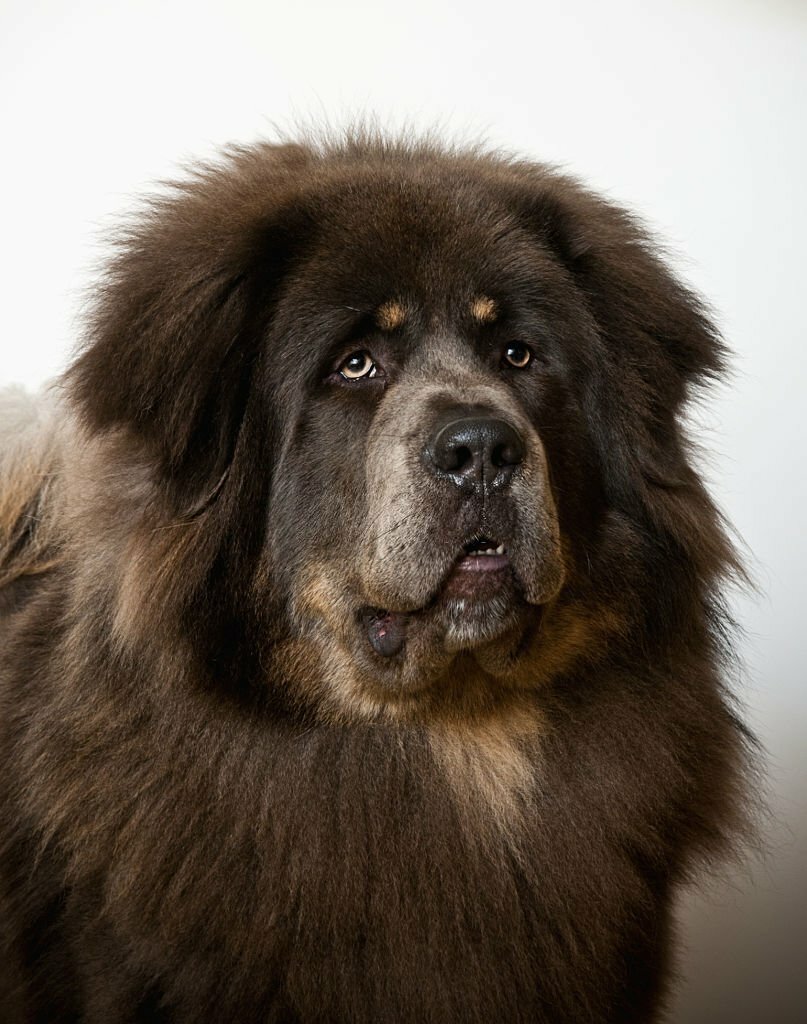
Tracing the origins of the Tibetan Mastiff is like piecing together a historical puzzle that spans time and various cultures. Researchers don’t just look at old texts; they also study the dog’s DNA, which shows links to ancient dog breeds.
Here’s what we know about the Tibetan Mastiff’s past:
These dogs have evolved to survive in high-altitude areas and have been essential companions for nomadic groups. There’s a lot of discussion about whether Tibetan Mastiffs are closely related to wolves due to their genetics.
Tibetan monks and herders have selected certain traits for generations, shaping the breed we see today.
Westerners have had their views on the dog, influencing how we classify and name the Tibetan Mastiff.
As breeding practices change, there’s a concern about maintaining the dog’s original traits.
Ancient Lineage Exploration
The Tibetan Mastiff has a long history that starts with the nomads of Central Asia, who used the dogs as guardians for their herds and homes. This impressive breed originated in Tibet, surrounded by the towering Himalayan mountains. Its past is closely tied to Tibetan traditions and way of life. These dogs were highly valued not just for their protective abilities but also as a mark of prestige.
Their fame spread to the West during Queen Victoria, adding to their international reputation. Research into the Tibetan Mastiff’s genetics shows connections to other large dog breeds, which helps us understand their place in the story of dog evolution.
Nomadic Culture Influence
The Tibetan Mastiff stands as a testament to the nomadic cultures of ancient Tibetan tribes. These impressive dogs were vital to shepherds, protecting their flocks and homes against predators in the harsh mountain landscapes.
Their behavior and physical traits reflect the needs of a life constantly on the move. With a muscular build and a naturally authoritative demeanor, Tibetan Mastiffs were bred over generations to be resilient and commanding – qualities that made them perfect for their role in these wandering communities.
Wolf-like Ancestry Debate
The Tibetan Mastiff has a mysterious background that intrigues dog geneticists and historians. Its lineage traces back to ancient wolf-like canines, setting it apart from other large dog breeds. Early Western explorers incorrectly labeled the species, adding to the confusion about its origins.
The breed’s genetic makeup has been further clouded by excessive breeding and inbreeding, raising questions about how much of its wolf-like heritage remains intact. The Tibetan Mastiff also has physical traits, like higher hemoglobin levels, ideal for surviving in high altitudes, adding another layer to the ongoing debate about its ancestry.
The blend of selective breeding and natural adaptations plays a crucial role in piecing together the breed’s intriguing genetic history.
Physical Dimensions
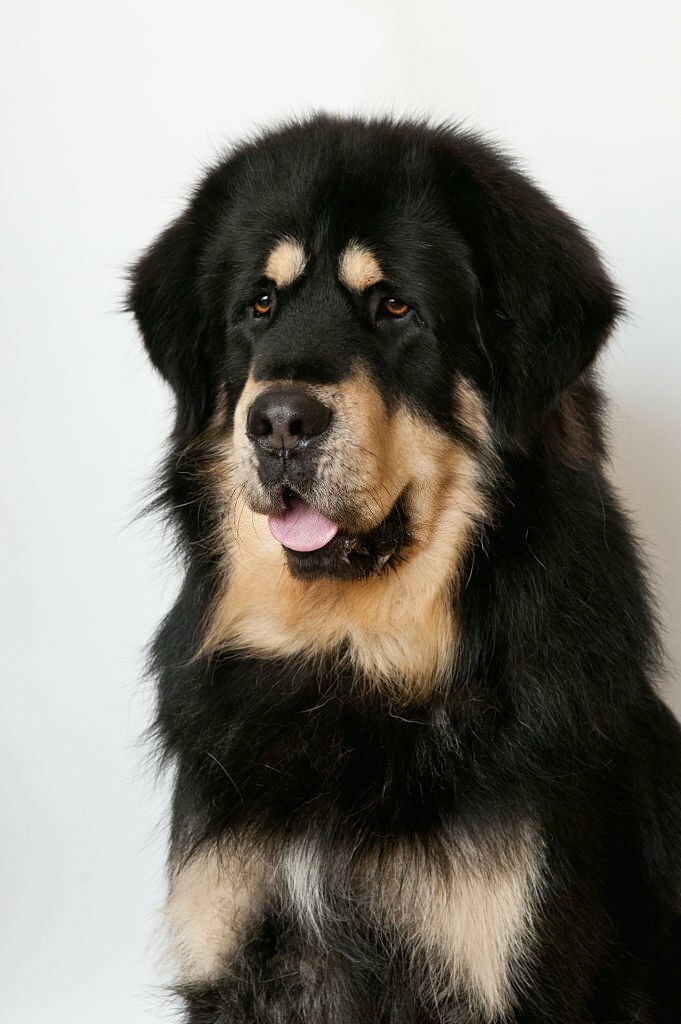
The Tibetan Mastiff stands out for its impressive size and strength. These majestic dogs show apparent differences between males and females, with males generally taller and heavier.
When assessing the physical attributes of the Tibetan Mastiff, you’ll note several aspects:
- Size and Weight: These dogs are known for their robust stature. Males often weigh more and stand taller than females, emphasizing the breed’s distinct sexual dimorphism.
- Coat Length: Their long, thick coats provide insulation and protection from harsh weather, a feature that speaks to their origin in high-altitude environments.
- Build and Structure: The Tibetan Mastiff’s solid build contributes to its ability as a guardian dog, capable of warding off predators and protecting livestock.
- Color Variations: They come in various colors ranging from black and brown to gold and blue-gray, showcasing the breed’s diverse genetics.
- Tail Characteristics: Their tail curls over the back, a characteristic that adds to their regal appearance and distinguishes them from other large breeds.
Understanding these traits helps explain why the Tibetan Mastiff is both respected as a working dog and admired as a loyal companion.
Size and Weight
Male Tibetan Mastiffs stand at 26 inches or more tall, while females are typically not shorter than 24 inches. Their considerable size is one of their most notable traits.
Males have a weight range of 90 to 150 pounds, and females vary between 70 and 120 pounds. Maintaining a healthy weight is vital for these dogs, as extra weight can lead to joint problems.
Owners of this giant breed must monitor their pets’ growth to support a strong bone structure. Keeping their body proportions balanced is vital to the dogs’ health and longevity.
Coat Length
Tibetan Mastiffs have long coats that are excellent for cold weather protection. Their thick, double skin keeps them warm but requires regular grooming to keep them in good condition.
They lose their undercoat during shedding seasons, which requires more frequent grooming sessions. Using a slicker brush on your Tibetan Mastiff to handle the shedding can help remove the loose hair effectively.
A good brushing routine is once a week to help spread the skin’s natural oils, clear out dirt, and stop the fur from tangling. This grooming keeps your dog looking good and their coat doing its job—protecting them from the elements.
Keeping up with these grooming practices is critical to maintaining the unique, beautiful coat of your Tibetan Mastiff.
Build and Structure
Tibetan Mastiffs are imposing and strong, with males often towering over 26 inches and females standing at least 24 inches tall. Their stature is even more remarkable when compared to other large dogs like the Bernese Mountain Dog; Tibetan Mastiffs showcase a broad and muscular build that signals their strength and stamina.
Males can weigh up to 150 pounds and females up to 120 pounds, with their weight evenly spread across their frame, adding to their majestic look. Their thick double coat, sometimes marked with striking white patterns, draws attention to their noble posture, especially the thick ruff around their neck and shoulders that resembles a lion’s mane.
This breed’s design isn’t just for aesthetics; it reflects their storied past of hardiness and adaptability.
Color Variations
The Tibetan Mastiff stands out for its robust build, commanding presence, and various coat colors. These colors range from a deep, dark black to softer shades of gold, adding to the breed’s noble look.
This dog can have a single-color coat or a two-tone pattern, with the well-known black and tan being a famous example. Their double coat serves practical and aesthetic purposes, displaying solids or combinations with tan, mahogany, or gold accents.
Not all colors are typical for the breed, with some, like the all-red or unusual short-haired coats, being less common.
Tail Characteristics
The Tibetan Mastiff is known for its impressive tail that curves over its back, contributing to the dog’s powerful look. This distinct tail is not just for show; it’s a vital part of their anatomy for communication and maintaining balance.
These large dogs have tails that match their size, and a whole, feathered appearance provides extra warmth, which is perfect for their origin in cold environments. At dog shows, the curl of their tail is a crucial point of interest, as it’s one indicator of the breed’s standards.
Behavioral Traits
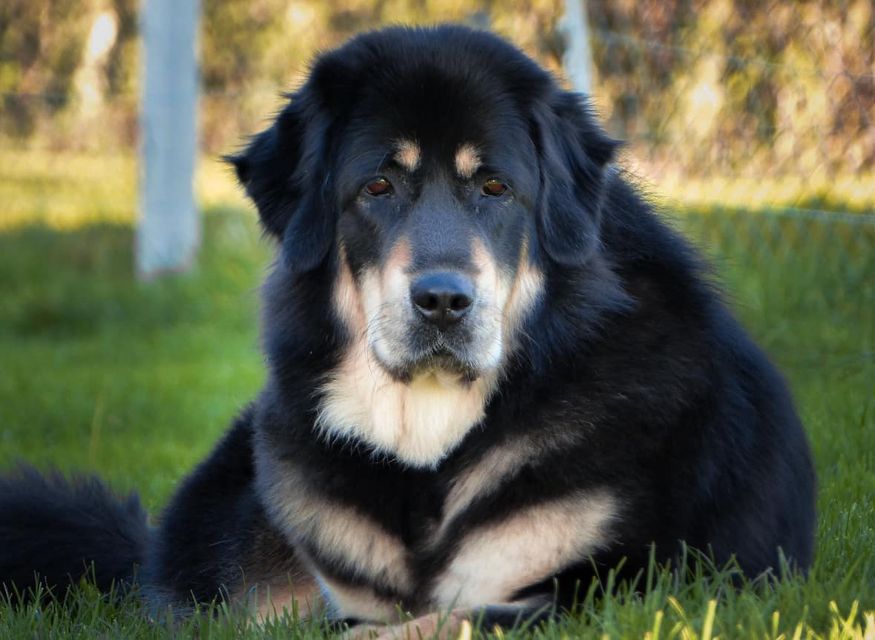
The Tibetan Mastiff is known for its guardian instincts, which are inherent and manifest strongly as they protect their loved ones. Understanding and managing their natural prey drive is crucial for responsible ownership and requires consistent training.
Socializing these dogs is vital to help them become more welcoming of unfamiliar faces, reducing their natural suspicion of strangers. Their intelligent and self-reliant traits can make training challenging, but patience leads to a well-adjusted dog.
Tibetan Mastiffs can be great family dog, showing deep loyalty and affection to their owners. Their compatibility with a family setting is significant, and their devotion is a reward for those who understand and meet their needs.
Guarding Instincts
The Tibetan Mastiff is naturally alert and has a strong sense of guardianship, making it an excellent watchdog. It quickly notices newcomers and assesses potential dangers, protecting its home and loved ones.
While the Tibetan Mastiff is cautious around strangers, it shows a softer side with family, especially children.
Proper socialization ensures it interacts well with people outside the family. This helps the dog balance its protective nature with being able to handle new experiences and environments.
Prey Drive Management
If you have a Tibetan Mastiff, it is essential to manage their prey drive with proper training and careful monitoring. This breed is known for being independent and sometimes stubborn, which makes consistent training and a strong leader vital.
Obedience training and socialization are vital in teaching them to behave around other animals and people. For their safety and the safety of others, a secure fence is a must-have to prevent them from chasing after animals when they’re outside.
High-quality dog food will keep them healthy and more responsive during training sessions. By directing the Tibetan Mastiff’s instincts appropriately, they can adapt well to living with families and in communities.
Socialization Importance
Every Tibetan Mastiff needs regular socialization to grow into a well-adjusted dog. If they aren’t introduced to different people and situations early on, they might become too guarded or show aggression without cause. Teaching a Tibetan Mastiff puppy how to interact with others during its early months is wise. This way, they learn to be cautious without being overly aggressive.
When new people or pets enter their home, a well-socialized Tibetan Mastiff knows how to behave. They can be protective without danger and live peacefully with everyone, including kids. This shows why it’s essential for Tibetan Mastiffs to get used to different experiences early on, helping them fit in with their human families.
Training Challenges
Moving from socializing to training, owners of Tibetan Mastiffs might face hurdles due to the breed’s inherent stubbornness and love for autonomy. These traits often make housebreaking a challenging task that requires a dog owner who is both patient and knowledgeable.
Tibetan Mastiffs also have certain genetic traits that could affect their behavior, underscoring the importance of early and thorough health checks as part of their training plan. Practical training of these noble dogs demands consistent effort and a solid grasp of dog behavior to ensure their self-reliant streak supports, rather than obstructs, their learning and integration into home life.
Family Compatibility
Tibetan Mastiffs are known for their noble nature, showing loyalty and a protective streak, which is great for families wanting a watchful pet. The American Tibetan Mastiff Association notes that although they are generally good with kids, their large size and protective behavior mean they’re more suitable for homes with older children who understand how to interact respectfully.
Younger kids should be supervised around these dogs because of their strong personalities and sheer size, which could unintentionally cause injury.
Careful attention to their socialization and training is essential to ensure a Tibetan Mastiff fits nicely into a family. With the proper upbringing and a family aware of their needs, these dogs can become valuable to the household.
Tibetan Mastiff Health Problems & Management
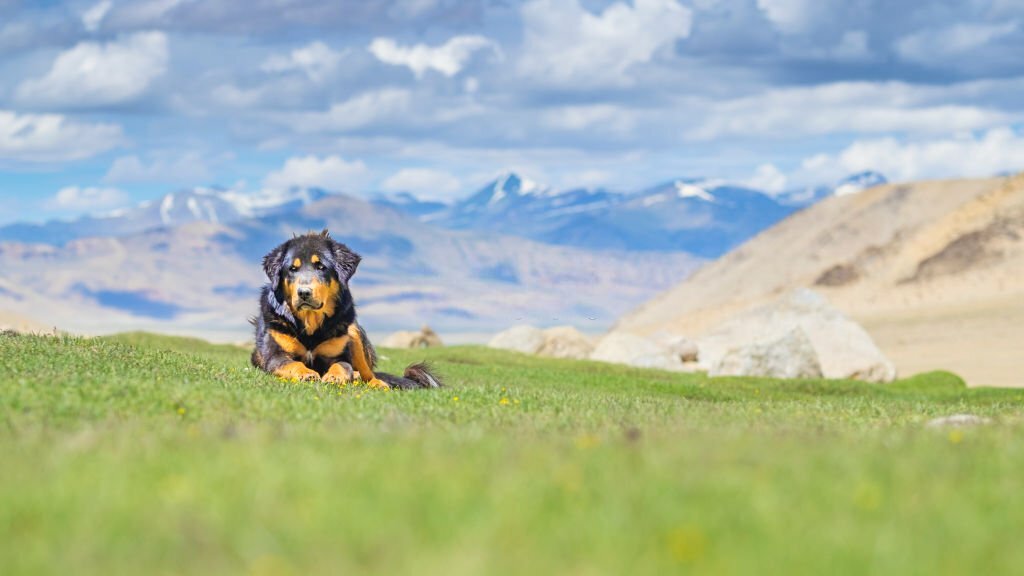
Tibetan Mastiffs, known for their longevity, must be watched for genetic disorders affecting their health. Owners should practice proactive health management, which includes preventative care, regular vet visits, and ethical breeding to safeguard their dogs’ well-being.
Key aspects of their care include:
- Screening for hip dysplasia and hypothyroidism is a must to catch any issues early.
- A well-rounded preventative care routine should be in place, ensuring up-to-date vaccinations and protection against parasites.
- A balanced diet is vital for maintaining a healthy weight, which is crucial for these large dogs to prevent joint stress.
- Owners should also focus on keeping their dogs mentally and physically active to prevent obesity and its complications.
- Promoting ethical breeding practices can help decrease the chances of passing on detrimental traits.
Common Genetic Disorders
The Tibetan Mastiff is an imposing dog known for its protective instincts, but it’s prone to genetic disorders requiring attentive health care and regular vet visits.
One concerning hereditary condition in this breed is Canine Inherited Demyelinative Neuropathy (CIDN), which highlights the need for thorough health screenings.
Hip dysplasia is another common issue, making responsible breeding and early checks, such as Orthopedic Foundation for Animals (OFA) screenings, vital for these dogs.
They may also suffer from low thyroid function or hypothyroidism, affecting their metabolism and overall well-being.
Regular eye exams are critical, too, because this breed often develops retinal atrophy, a condition that can lead to vision loss.
Preventative Care Strategies
Caring for Tibetan Mastiffs involves a dedicated preventative care routine. This includes regular visits to the vet and following health guidelines tailored to their needs. Owners need to watch for typical health problems, especially hypothyroidism, which might require daily treatment. Including heart and hip exams in their regular health check-ups is also vital.
When choosing a breeder, it’s essential to pick one who provides health clearances for the dogs’ hips, elbows, and thyroid, which helps reduce the risk of inherited health issues.
Hearing health is another critical aspect of care for these dogs. Owners should regularly inspect their Tibetan Mastiff’s ears for signs of infection or irritation. Cleaning their ear canal as needed can help prevent ear problems.
Taking these steps seriously is critical to ensuring a healthy and happy life for these impressive dogs.
Lifespan Optimization Tips
To help Tibetan Mastiffs live longer, a well-rounded care plan is critical. This includes consistent health check-ups, a diet that meets their nutritional needs, and the right dog of the amount of exercise. These dogs must get tested for common conditions like hip dysplasia and hypothyroidism. Early detection means these issues can be managed, sometimes with daily medication.
Feeding Tibetan Mastiffs the correct diet is vital to keep them in good shape and avoid heart issues. They also require frequent grooming, which isn’t just for looks—it’s essential for maintaining skin health.
With attentive care, owners can help extend their Tibetan Mastiffs’ lives and ensure they enjoy their years in the best possible health.
Maintenance Requirements
Caring for a Tibetan Mastiff involves a well-planned routine to keep them healthy and content. Owning one means you need to pay close attention to several care aspects that are vital for this breed’s well-being.
Here are the main points to keep in mind:
- Regular grooming is necessary due to their thick fur.
- A Tibetan Mastiff needs consistent exercise to stay fit and happy.
- Regular health check-ups by a vet will help prevent and address issues early.
- A proper diet is vital to maintaining their health.
- Lastly, a commitment to ongoing training is critical for their behavior and socialization.
Grooming Frequency
Grooming a Tibetan Mastiff is vital for their health and your home’s cleanliness. Brushing them once a week and bathing them every month is a good routine. When they shed more heavily, usually twice a year, you’ll want to brush them twice weekly to control the fur.
Ear care is also a vital part of their grooming. Use a soft cotton ball to gently clean their ears gently, preventing any wax build-up that could cause infections.
Taking care of a Tibetan Mastiff is not overly demanding but requires consistent attention.
Exercise Needs
Exercise is vital for a Tibetan Mastiff, but it needs to be carefully tailored to their moderate energy levels and to prevent joint issues. Despite their large size, these dogs don’t need intense workouts. A balanced routine is best, with daily walks at a relaxed pace recommended by groups like Mastiff Rescue.
These walks are preferred over the rough play of a dog park, which can stress their joints.
For Tibetan Mastiffs, especially during their growth phase, avoiding activities that might worsen inherited conditions such as hip dysplasia is essential. The focus should be on maintaining their health with well-planned exercise that supports their physical well-being without harming their bones.
Health Check-Ups
Regular vet visits are vital to the health of Tibetan Mastiffs, helping to catch and manage hereditary conditions early. These impressive dogs are prone to health issues like hypothyroidism and hip dysplasia, so close health monitoring is essential.
Vets often suggest tests for Canine Inherited Demyelinative Neuropathy (CIDN), among other common problems in these dogs. Keeping up with health check-ups allows for early treatment, slowing disease progression.
Getting health clearances for hips, elbows, and thyroid from reputable organizations is part of proactive care for your Tibetan Mastiff’s health.
Feeding Regimen
Tibetan Mastiffs don’t need a lot of food, but watching their diet is necessary to keep them healthy and avoid excess weight. These dogs are known for being self-reliant and protective, and they have distinct dietary needs that change as they grow from puppies into adults.
People considering getting a Tibetan Mastiff should know the breed’s tendency to gain weight quickly. Therefore, monitoring their importance and how much they eat is essential.
Throughout their lifetime, Tibetan Mastiffs need a diet high in protein and minimal grains to support their muscular build and aid digestion. Setting a consistent feeding routine and regular exercise helps meet their needs while preventing overeating. This careful approach is essential to reduce health risks such as bloat, a severe condition for large dogs.
Training Commitment
Training a Tibetan Mastiff requires ongoing dedication as they value their independence. Owners must persistently train and adapt their methods throughout the dog’s life to ensure they thrive in the family.
Setting clear rules and reinforcing good behavior in these dogs is necessary to avoid issues with dominance or overprotectiveness. Given their size and the natural wariness of strangers, it’s also essential for owners to be able to manage them physically if the situation calls for it.
On top of training, regular dental care for Tibetan Mastiffs is critical for their health.
Dietary Guidelines
The Tibetan Mastiff is a powerful breed that thrives on a diet tailored to its specific nutritional needs. As they grow older and their activity levels vary, they must adjust their meal sizes and frequency to keep them healthy and avoid weight gain.
Pay attention to any signs of food allergies or sensitivities, which can significantly impact their health. Providing a well-rounded diet rich in proteins, fats, carbohydrates, vitamins, and minerals is vital for these large dogs.
Monitor their diet and make changes based on their age, current weight, and exercise habits. Be aware of common allergens that might affect the Tibetan Mastiff, such as specific proteins or grains. Include foods that promote strong joints to help prevent hip and elbow dysplasia, which the breed is prone to.
Regular check-ins with a vet are recommended to ensure your dog’s diet meets their needs and to tackle any health problems that might stem from poor nutrition.
Nutritional Needs
When feeding Tibetan Mastiffs, following breed-specific advice is essential to keep them healthy and avoid overfeeding. Though large, these dogs don’t need as many calories as you think. High-quality dog food that matches a Tibetan Mastiff’s energy is critical.
Experienced breeders often have the best dog advice on what and how much to feed puppies to prevent issues like obesity. Being aware of health check results for conditions that affect the joints and thyroid, which the Orthopedic Foundation can provide for Animals, is vital since these factors can affect their dietary requirements.
Carefully sticking to the advised amount of food and avoiding feeding right after exercise are good practices to prevent bloat, ensuring these noble dogs stay healthy for years.
Feeding Frequency
Knowing how often to feed a Tibetan Mastiff is critical to their health and well-being. Structured meal times are better than allowing the dog to eat whenever it wants, which can cause weight gain and worsen joint issues like hip dysplasia.
These large dogs have unique dietary needs that have developed over time, and many experts agree that adult Tibetan Mastiffs should eat at least twice per day. This helps control their food portions and keeps them in good shape.
Sticking to a regular feeding routine also promotes digestive health and reduces the chances of bloat, a serious health threat for this breed.
Allergies and Sensitivities
When feeding a Tibetan Mastiff, it’s vital to watch out for food allergies and sensitivities that could harm their health. These large and alert dogs, officially recognized by the American Kennel Club, might experience adverse reactions to certain foods.
Owners should carefully monitor their dogs and note if food causes adverse symptoms. A well-planned diet is essential for this breed due to their genetic predisposition to specific health issues like thyroid problems.
It’s also wise to monitor the environment since allergens from outside can affect a Tibetan Mastiff’s dietary health.

